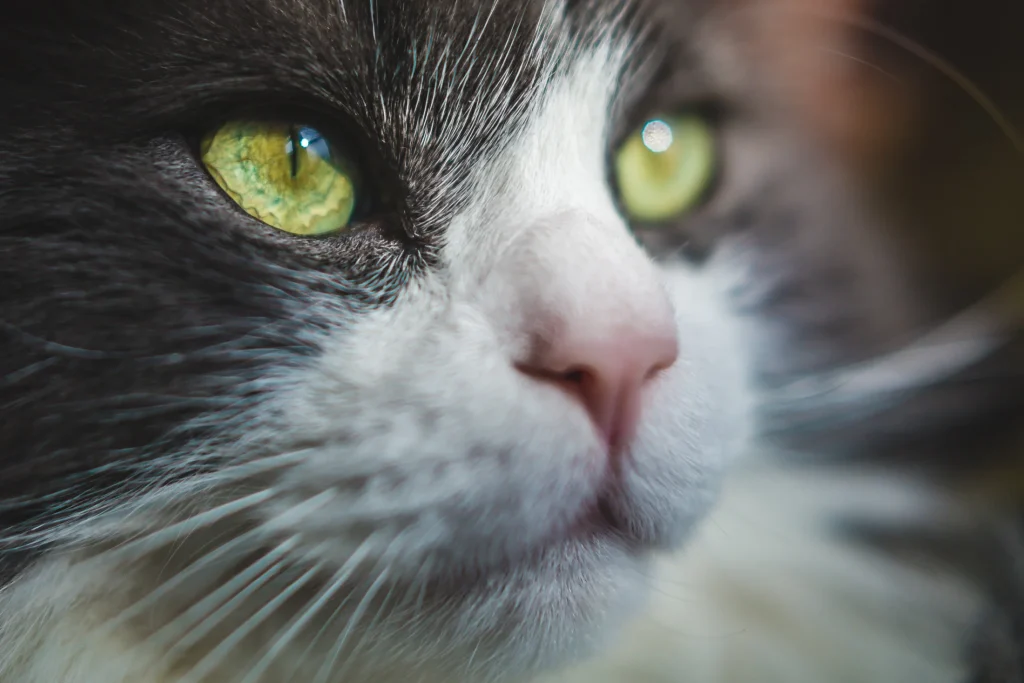Cat language – including cat talk and meowing variants – is absolutely essential for understanding the fascinating world of cats. Just as humans prefer to communicate by talking, cats often prefer silent communication. Cats often prefer to express themselves through body language and behaviours such as meowing or sniffing.
If you want to get to know and understand the tiny members of your family more closely, you first need to get to the basics of cat language. If you are wondering how to recognise your cat, our ‘understanding cat language’ content for Catvenience meowblog is just the kind of adventure that will make your mustachemoustache tremble! So let’s get started…
Vocalizing With Meows, Purrs, and More
Ah, the language of meows! Cats, like many animals, use their vocalisations to express their emotions. Sounds such as meowing, purring, hissing and growling vary in the feline repertoire depending on their context, and each cat’s vocalisation style is unique. More interestingly, however, adult cats do not prefer to meow when communicating with each other. Sounds like meowing are more reserved for communicating with humans. Some research shows that meowing sounds are more of a manipulative behaviour that cats adopt to get what they want from their owners. Yes, cats are much smarter and more cunning than you think!
Maybe they can’t talk like us, but with the slightest meow sound, they can attract the attention they want by saying ‘hey human, give me all your attention!
Cats Ear Talk
Cats express their emotions with their ears as well as sounds such as meowing. But how?
- If your cat’s ears are erect and pointing forwards, they are expressing interest. A situation, event, sound or smell around them may have attracted their attention.
- If your cat’s ears are slightly tilted to the side, it means that they are peaceful and comfortable. It shows that they do not perceive any threat in their environment and feel safe.
- If your cat’s ears are tilted back or to the side, then it may be feeling danger and fear! It takes a defensedefence position in case of contact it does not like.
- If your cat’s ears are moving fast, it may be anxious and analysing the sounds around it.
- If the cat’s ears move backwards and slightly downwards, it shows a sign of docility and submission to the alpha cat or human.
Cats Eye Talk
Cats can express their emotions with their eyelids and dilated pupils. Let’s look at what your cat says according to its eye expressions:
- Wide-open eyes: Express curiosity, arousal and attention. They may have noticed something around them and may be excited and confused.
- Narrowed pupils: May express fear, aggression and anger. They may focus like this when they perceive a threat, or even when their hunting instinct is aroused.
- Slow Blink (Cat Kiss): Our favourite! It signals trust and love. When your cat blinks gently and responds to you, it shows that it is safe and happy. This is the message ‘I love you’.
- Half Closed, Squinted Eyes: It expresses comfort and trust. They make this movement when they are about to fall asleep.
- Hard and Direct Eye Contact: Expresses challenge and threat. Cats often perceive direct eye contact as a threat. If it exhibits this gesture, it is in alert or defensedefence mode.
- Rapid Eye Movement: Distraction and investigation. It may be trying to analyse new elements and threats in its environment.
- Eyes completely closed: Unconditional trust. It shows that it trusts the environment and people around it.
You can better understand the emotional state of cats by evaluating their eye movements together with their ear positions and tail movements. Their body language is the key to understanding how they feel. 🐱
Cats Tail Talk
You can recognise cats’ emotions and reactions to environmental stimuli by their tail movements. Here’s what the tails of little pumpkins tell us:
- Cats often hold their tails erect when they want to be approached and when greeting their owners. This shows trust, affection and friendliness.
- If their tail wags like a whip, it’s a sign that you should keep your distance.
- If the tail feathers are fluffy and erect, they are in a defensive and aggressive state.
- A tail wagging back and forth can be a sign that they are playing games or are nervous.
- If the tail is tucked between the legs, the cat is very frightened. It shows that it feels threatened and defenselessdefenceless.
Cats Smell Tips
Another way cats use to communicate is by releasing their scent. Humans do not always understand the smell cues that cats use to communicate, but these codes mean a lot to cats.
The scent messages cats leave for other cats to read include urine, defecation, bunting (rubbing against the body), fecal marking and clawing. To understand cats, you can look at big cats. Like all their ancestors, they are territorial. So the smell they leave behind sends the message ‘this territory is mine’ in the event of a foreign invasion. Cats’ sense of smell is so developed that even as a small kitten, they can smell the smell before they see it. Just like my cat can smell food through a closed door 😅
Cats Body Talk
A cat’s body posture shows everything from confidence to fear, submission, aggression or affection. To understand your cat’s body language, you need to read what the eyes, ears, tail and vocalisations express. For example, if a cat arches its back and fluffs its fur, it may be feeling scared or threatened. This is a defensedefence mechanism to make itself look bigger and more threatening than it really is.
If a cat moves slowly, keeping its body close to the ground, it may be focussed on a target, usually during hunting or play. This is a reflection of its hunting instincts. At the same time, if it rolls onto its back and shows its belly, it usually means that it feels comfort and security. However, this is not always an invitation to ‘touch me’! Some cats can be defensive even in this position.
An upright and tense posture may indicate that the cat is attentive or is assessing a situation and preparing to react. On the contrary, a relaxed body position means that the cat is relaxed and feels safe.
Cats’ sudden leaps or runs often express a desire to play, such as a burst of energy. It can also be a momentary reaction to environmental stimuli. Context is very important for understanding cats’ body movements. Their movements should be evaluated together with their ear, eye and tail positions, so you can understand your cat’s language!
Clean sand, happy cat! Take your cat’s health to the highest level with our ‘Pine Pellet Cat Litter’ product, which we have prepared based on the idiom!

